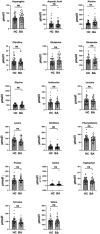Infants with biliary atresia exhibit an altered amino acid profile in their newborn screening
- PMID: 39369162
- PMCID: PMC11455667
- DOI: 10.1007/s11306-024-02175-2
Infants with biliary atresia exhibit an altered amino acid profile in their newborn screening
Abstract
Introduction: Biliary atresia (BA) is a rare progressive neonatal cholangiopathy with unknown pathophysiology and time of onset. Newborn Screening (NBS) in Germany is routinely performed in the first days of life to identify rare congenital diseases utilizing dried blood spot (DBS) card analyses. Infants with biliary atresia (BA) are known to have altered amino acid profiles (AAP) at the time point of diagnosis, but it is unclear whether these alterations are present at the time point of NBS.
Objectives: We aimed to analyze amino acid profiles in NBS-DBS of infants with Biliary Atresia.
Methods: Original NBS-DBS cards of 41 infants who were later on diagnosed with BA were retrospectively obtained. NBS-DBS cards from healthy newborns (n = 40) served as controls. In some BA infants (n = 14) a second DBS card was obtained at time of Kasai surgery. AAP in DBS cards were analyzed by targeted metabolomics.
Results: DBS metabolomics in the NBS of at that time point seemingly healthy infants later diagnosed with BA revealed significantly higher levels of Methionine (14.6 ± 8.6 μmol/l), Histidine (23.5 ± 50.3 μmol/l), Threonine (123.9 ± 72.8 μmol/l) and Arginine (14.1 ± 11.8 μmol/l) compared to healthy controls (Met: 8.1 ± 2.6 μmol/l, His: 18.6 ± 10.1 μmol/l, Thr: 98.1 ± 34.3 μmol/l, Arg: 9.3 ± 6.6 μmol/l). Methionine, Arginine and Histidine showed a further increase at time point of Kasai procedure. No correlation between amino acid levels and clinical course was observed.
Conclusion: Our data demonstrate that BA patients exhibit an altered AAP within 72 h after birth, long before the infants become symptomatic. This supports the theory of a prenatal onset of the disease and, thus, the possibility of developing a sensitive and specific NBS. Methionine might be particularly relevant due to its involvement in glutathione metabolism. Further investigation of AAP in BA may help in understanding the underlying pathophysiology.
Keywords: Dried blood spot analysis; Hypermethionemia; Pediatric hepatology; Targeted metabolomics.
© 2024. The Author(s).
Conflict of interest statement
All authors declare that they have no conflicts of interest and no competing interests (no financial or non-financial interests) to disclose. No external funding was received for this study.
Figures




References
-
- Abukawa, D., Ohura, T., Iinuma, K., & Tazawa, Y. (2001). An undescribed subset of neonatal intrahepatic cholestasis associated with multiple hyperaminoacidemia. Hepatology Research: The Official Journal of the Japan Society of Hepatology,21(1), 8–13. 10.1016/s1386-6346(01)00079-1 - PubMed
-
- Byrd, D. J., Wiltfang, A., Rodeck, B., Latta, A., Burdelski, M., & Brodehl, J. (1993). The plasma amino acid profile and its relationships to standard quantities of liver function in infants and children with extrahepatic biliary atresia and preterminal liver cirrhosis. European Journal of Clinical Chemistry and Clinical Biochemistry: Journal of the Forum of European Clinical Chemistry Societies,31(4), 197–204. 10.1515/cclm.1993.31.4.197 - PubMed
-
- Creeden, J. F., Kipp, Z. A., Xu, M., Flight, R. M., Moseley, H. N. B., Martinez, G. J., Lee, W.-H., Alganem, K., Imami, A. S., McMullen, M. R., Roychowdhury, S., Nawabi, A. M., Hipp, J. A., Softic, S., Weinman, S. A., McCullumsmith, R., Nagy, L. E., & Hinds, T. D. (2022). Hepatic kinome atlas: An in-depth identification of kinase pathways in liver fibrosis of humans and rodents. Hepatology (Baltimore, Md.), 76(5), 1376–1388. 10.1002/hep.32467 - PMC - PubMed
MeSH terms
Substances
LinkOut - more resources
Full Text Sources
Medical
Research Materials
Miscellaneous
